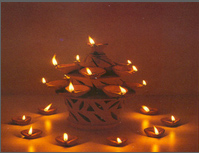Diwali, originally the name Deepawali oriented from Sanskrit that literally means “Row of Deep”. It signifies the triumph of good over evil. The festival is important to Hindus, Jains and Sikhs. On this day there is an official holiday in India, Guyana, Trinidad & Tobago, Mauritius, Malaysia, Nepal, Singapore, Sri Lanka, Burma and Fiji.
It is said to mark the return of Lord Rama to Ayodhya, variedly it celebrates the slaying of Narakasura by Lord Krishna and Satyabhama. In Jainism, Diwali marks the attainment of moksha by Mahavira in 527 BC. In Sikhism, Diwali commemorates the return of Guru Har Gobind Ji to Amritsar after freeing 52 Hindu kings imprisoned in Gwalior by Emperor Jahangir (1619).
For some it is a three-day festival. It commences with the Dhan-Teras, on the 13th day of the dark half of Kartik, followed by Narak Chaudas, the 14th day, and by Diwali on the 15th day.
Dhan Teras marks the beginning of the trader’s calendar in Northern India. The festival at a spiritual level means “awareness of the inner light”. Just as we celebrate the birth of our physical being, Diwali is the celebration of awakening of the inner light, to awaken to a transcendent reality. The light of realization, to slice through the darkness of ‘un-consciousness.’
In Gujarat, Diwali is associated mostly with the worship of Lakshmi – the goddess of wealth. The puja lasts for five days and starts with Dhanteras. The fourth day is Gujrati New Year’s Day.
In Bihar, the celebration of Diwali starts two days before the actual Diwali as Dhanteras, celebrated in honor of Dhanvantari, the celestial physician.
In Orissa the festivities are almost similar but have a unique ritual. Jute stems are burnt to light up the dark path of the spirits of the ancestors back to heaven. A rangoli of a sailboat is made. Its seven chambers hold cotton, mustard, salt, asparagus root, turmeric and a wild creeper. A jute stem is lit at the beginning of the Puja. All members of the household light their jute stem from the flame on the rangoli and chant:
“Bada Badua Ho, Andhaara Re Aasa, Aluwa Re Jaa.
Baaisi Pahaacha Re Gada Gadau Tha.”
(“O forefathers, come to us in this dark evening, we light your way to heaven. May you attain salvation on the 22 steps of the Jagannath temple of Puri.”)
Additionally a mortar, pestle and plough are also worshipped. Night long vigil ensues with all doors open so that Devi Laxmi does not return from any household. Other than that its the usual, bright lights and fire crackers and lots and lots of sweetmeats and joy and laughter all around.
Across Eastern India the day is celebrated as ‘Kali Puja’. Kali, the consort of ‘Kala’ – Mahadev. Of course in my childhood Kali Puja had a very special significance. Joys of firecrackers and staying up late. This was one day we were allowed to stay up as long as it took for the puja’s to get over – mostly in the wee hours of the morning. I can still feel the descending chill of the oncoming winter, of the warmth of the soft shawl sitting through the pujas – happy, excited, expectant and sleepy.
In 2010, Diwali festival is celebrated on November 5th. Toshali Sands welcomes all to be the part of Diwali Festival experiencing, exclusive arrangement has been done for the guest to witness and be the part of the festival. For Diwali Package and online hotel Reservation click on http://bit.ly/csR4ol . For more details on customized Diwali festive budget tour contact travel planner to metu@toshali.in
If you feel, we have missed any information that is helpful for your friends visiting this blog, do post. We would be glad to receive your comments and conversation.
